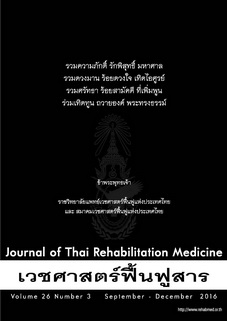ค่าบริการและการจ่ายเงินแบบกลุ่มวินิจฉัยโรคร่วมของผู้ป่วย หอผู้ป่วยเวชศาสตร์ฟื้นฟู โรงพยาบาลศิริราช
ค่าบริการและการจ่ายเงินแบบกลุ่มวินิจฉัยโรคร่วมของผู้ป่วย หอผู้ป่วยเวชศาสตร์ฟื้นฟู โรงพยาบาลศิริราช
Keywords:
inpatient rehabilitation service, hospital charge, DRGs paymentAbstract
Objective: To study hospital charges and diagnosis related groups (DRGs) payment of inpatients admitted at rehabilitation ward, Siriraj Hospital
Study design: Descriptive study .
Setting: Rehabilitation ward, Siriraj Hospital
Subjects: All patients admitted to rehabilitation ward and discharged during February 22 to June 28, 2014
Methods: Data collected from medical records and financial division of Siriraj Hospital
Results: Sixty patients were studied: 50 (83.3%) were admitted from outpatient clinic and 10 (16.7%) were transferred from other wards. The most common principal diagnosis was spastic hemiplegia (31.7%). Mean length of stay (LOS) was 23.4 (SD 14) days. The average hospital charge of the total population, OPD group and transfer group were 74,102 (SD 64,110.4), 54,453.9 (SD 30,782.6) and 172,343.2 (SD 94,429.6) baht respectively while the average diagnosis related group (DRGs) payment of the total population, OPD group and transfer group were 44,777.8 (SD 65,323.7), 26,693.8 (SD 18,081.5) and 126,977.4 (SD 122,202.8) baht respectively. Spastic hemiplegia patients had highest mean hospital charge (60,497.4, SD 31,082 baht). Relative weight of transferred group (6.6) were significantly higher than those of OPD group (2.03) (P=0.002). Mean Barthel index (BI) increased significantly from 10.8 (SD 5.3) at admission to 13.3 (SD 5) at discharge (p<0.001).
Conclusion: Most patients were spastic hemiplegia. Mean LOS was about three weeks. Hospital charges were much more than the DRGs payments. And rehabilitation can improve patients’ function.
References
2. Kovindha A, Kuptniratsakul V, Dajpratham P, Massakulpan P, Piravej K, Archongka Y. Thai stroke rehabilitation registry (TSRR). J Thai Rehabili Med. 2007;17:31-6.
3. Kwakkel G, Kollen BJ, WagenaarRC ,R PS Van Peppen , Dekker J ,Ph J Van der Weeset al.Therapy impact on functional recovery in stroke rehabilitation. Physiotherapy. 1999;85:377-91.
4. Suputtitada A, Aksaranugraha S, Granger CV, Sankaew M. Result of stroke rehabilitation in Thailand. Disability and rehabilitation. 2003;25:1140-5.
5. Statistical report 2012 Department of Medical Services Ministry of Public Health. [Cited2016 Apr 7]. Available from: URL: http://203.157.32.40/statreport/2555/Statistic2555.pdf
6. Kuptniratsaikul V,Kovindha A, Massakulpan P, Permsirivanich W, Srisa-an Kuptniratsaikul P. Inpatient rehabilitation services for patients after stroke in Thailand. J Rehabil Med. 2009;41:684–6.
7. Kitisomprayoonkul W, Sungkapo P, Taveemanoon S, Chaiwanichsiri D. Medical complications during inpatient stroke rehabilitation in Thailand: A Prospective Study. J Med Assoc Thai. 2010; 93:594-600.
8. Kammuang-lue P and Kovindha A. A 3-year retrospective study on total admission charge of spinal cord injured patients with pressure ulcer at rehabilitation ward, Maharaj Nakorn Chiang Mai Hospital. J Thai Rehabli Med. 2012; 22:58-63.
9. Gupta A, Taly AB, Srivastava A, Murali T. Non-traumatic spinal cord lesions: epidemiology, complications, neurological and functional outcome of rehabilitation.Spinal Cord. 2009; 47:307–11.
10. Groot S, Dallmeijer AJ, Post MW, van Asbeck FW, Nene AV, Angenot EL, et al. Demographics of the Dutch multicenter prospective cohort study‘restoration of mobility in spinal cord injury rehabilitation’.Spinal Cord. 2006;44:668–75.
11. McKinley WO, Seel RT, Hardman JT. Nontraumatic spinal Cord Injury: incidence, epidemiology, and functional outcome. Arch Phys Med Rehabil. 1999;80:619-23.
12. Thai casemix center. Health system research institute’s affiliated agency. Thai diagnosis related group version 5.1.1. [cited 2016 Nov 27]. Available from: http://www.thaicasemix. com/CMS/index.php/86-thai-drg-version-51.
13. Sinoff G, Ore L. The Barthel activities of daily living index: self-reporting versus actual performance in the old-old. J Am Geriatr. 1997 ;45:832-6.
14. Gresham G, Phillips T, Wolf P, McNamara PM, Kannel WB, Dawber TR. Epidemiologic profile of longterm stroke disability: the Framingham Study, Arch Phys Med Rehabil. 1979;60:487-91.
15. Shaper AG, Phillips AN, Pocock SJ, Walker M, Macfarlane PW. Risk factors for stroke in middle-aged British men. Br Med J. 1991;302:1111-5.
16. O’Leary DH, Anderson KM, Wolf PA, Evans JC, Poehlman HW. Cholesterol and carotid atherosclerosis in older persons: the Framingham Study. Ann Epidemiol. 1992;2:147-53.
17. Kovindha A.Textbook of spinal cord injury: comprehensive rehabilitation2, vol 1. Chiangmai: Sutinkarnpim: 2013.
18. Khiaocharoen O, Pannarunothai S. The need for rehabilitation care of sub-acute and non-acute inpatients in Thailand. J Health Sci. 2012;21:761-73.
19. Manuela M, Pasquale M, Antonio P, Antonella L, Stefano FC, Aldo S, et al. Early versus delayed rehabilitation treatment in hemiplegic patients with ischemic stroke: propioceptive or cognitive approach?. Eur J Phys Rehabil Med. 2016;52:81-9.
20. Askim T, Bernhardt J, Salvesen O, Indredavik B. Physical activity early after stroke and its association to functional outcome 3 months later. J Stroke Cerebrovasc Dis 2014; 23:305-12.
21. Lynch E, Hillier S, Cadilhac D. When should physical rehabilitation commence after stroke: a systematic review. Int J Stroke 2014;9:468-78.
22. Liu N, Cadilhac DA, Andrew NE, Zeng L, Li Z, Li J, et al. Randomized controlled trial of early rehabilitation after intracerebral hemorrhage stroke: difference in outcomes within 6 months of stroke. Stroke. 2014;45:3502-7.
23. Wilder RP, Jenkins JG, Seto CK, Statuta S. Therapeutic exercise. In: Randell B. Physical medicine and rehabilitation, vol 4. Philadelphia: Elsevier: 2011. p.403-26.
24. Khiaocharoen O, Pannarunothai S, Riewpaiboon W, Ingsrisawang L, Teerawattananon Y. Economic evaluation of rehabilitation services for Inpatients with stroke in Thailand. Value in Health Regional. 2012;29-35.
25. Harnphadungkit K, Kheawcharoen O, Pannarunothai S. Service system and payment methods for medical rehabilitation service in Thailand. J Health Sci. 2009;18:18-32.
26. Sanpang P. Operation on medical records of in-patient and the request of money for the compensation of medical services: case study of Bangkok metropolitan administration general hospital 2012. [Cited 2014 Oct 27]. Available from: URL:http://libdcms.nida.ac.th/thesis6/2555/b176364.pdf






